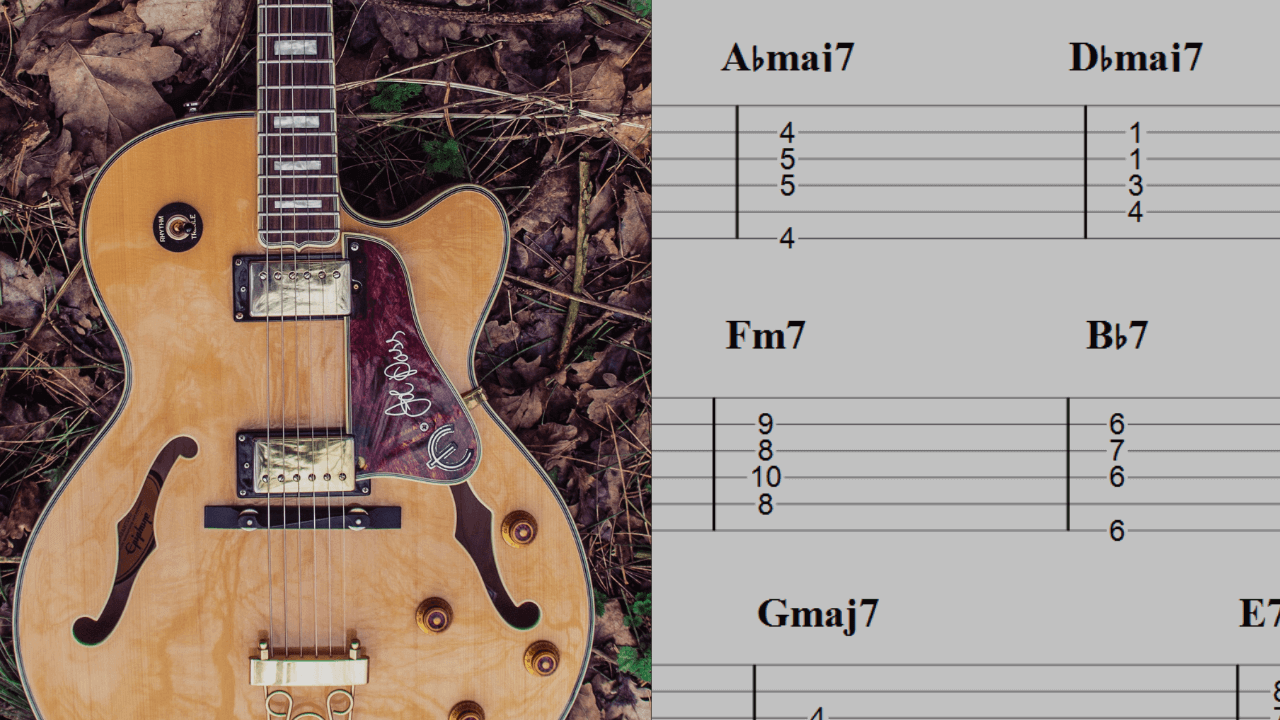Delving into the realm of music composition, there’s a profound fascination for the distinctive aura created by dark chord progressions.
This thematic exploration proves captivating for musicians and listeners alike.
Whether you’re a seasoned composer or a novice songwriter, these progressions hold immense potential for establishing a deeply engaging, eerily enchanting soundscape.
This blog is an insightful guide into such dark and mysterious musical territories.
Incorporating these into your work can endow it with a unique, mesmerizing edge.
Quick to grasp and extremely effective, these progressions can revolutionize your approach to creating music.
Table of Contents
- Dark Chord Progressions
- i – VI – III – VII (1-6-3-7)
- VI – VII – i (6-7-1)
- iv – VI – vii° (4-6-7)
- VI – III – iv – ii° (6-3-4-2)
- i – v – VI – III (1-5-6-3)
- ii – V – I (2-5-1)
- i – iv – VII – III (1-4-7-3)
- I – vi – IV – ii (1-6-4-2)
- IV – V – I (4-5-1)
- i – ii° – VII (1-2-7)
- ii – vi – V (2-6-5)
- VI – vii – I (6-7-1)
- iv – ii° – i (4-2-1)
- i – VI – iv – v (1-6-4-5)
- i – vii° – III – VII (1-7-3-7)
- i – IV – vii° – III (1-4-7-3)
- vi – IV – ii – I (6-4-2-1)
- The Bottom Line
Dark Chord Progressions
i – VI – III – VII (1-6-3-7)
This progression brings a haunting melancholy, perfect for eerie undertones.
The i – VI – III – VII chord progression provides a distinctive, haunting tonality to music, perfectly suited for creating a melancholic and slightly eerie ambience. Incorporating minor and major chords, it carries a sense of yearning and a dark undertone, making it an indispensable tool for music pieces intended to convey suspense, mystery or emotional turbulence.
- Difficulty: Intermediate
- Example: Cm – Ab – Eb – Bb (Key of C)
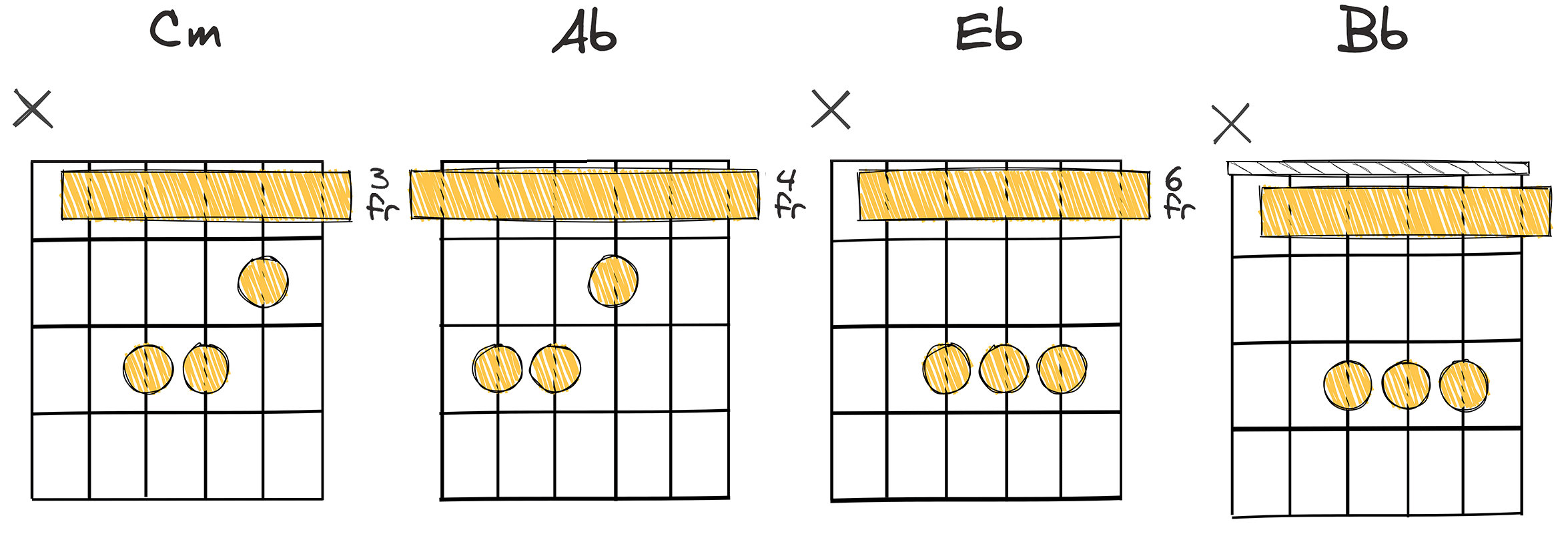
The dark chord progressions evoke certain emotions that can be hard to describe but are undeniably impactful.
One of these striking chord progressions is the i – VI – III – VII, also known as 1 – 6 – 3 – 7 in the Key of C or Cm – Ab – Eb – Bb
Although this chord progression resides in the domain of intermediate players, a thoughtful practice schedule can make it accessible to even the budding musicians.
The evocative quality and the general mood that this progression produce have made it a frequent choice among composers throughout history.
In history, this progression was favored by many classical composers as they found it provided a pleasing change from the otherwise more common, happier chord progressions.
Drawing from its classical roots, this progression has been used by modern pop artists as well, becoming popular due to its ability to create unique sonic atmospheres.
While this progression is potent, it’s crucial to experiment with different rhythmic patterns and chord voicings in order to prevent your music from falling into predictable territory.
In learning this progression, it would be beneficial to analyse and play pieces that use it in order to get a feel for this progression’s distinct character.
It is without doubt, this level of understanding would go a long way in allowing musicians to independently explore the vast sonic possibilities this progression offers.
VI – VII – i (6-7-1)
Ascending progression unveiling mysterious, haunting tonal landscapes.
The VI – VII – i progression is a haunting sequence that can effectively induce an unsettling or spooky atmosphere in your music. The transition from the sixth and seventh chords to the first creates a dark, melancholic mood, perfect for adding an eerie edge to your composition.
- Difficulty: Intermediate
- Example: Ab – Bb – Cm (Key of C minor)
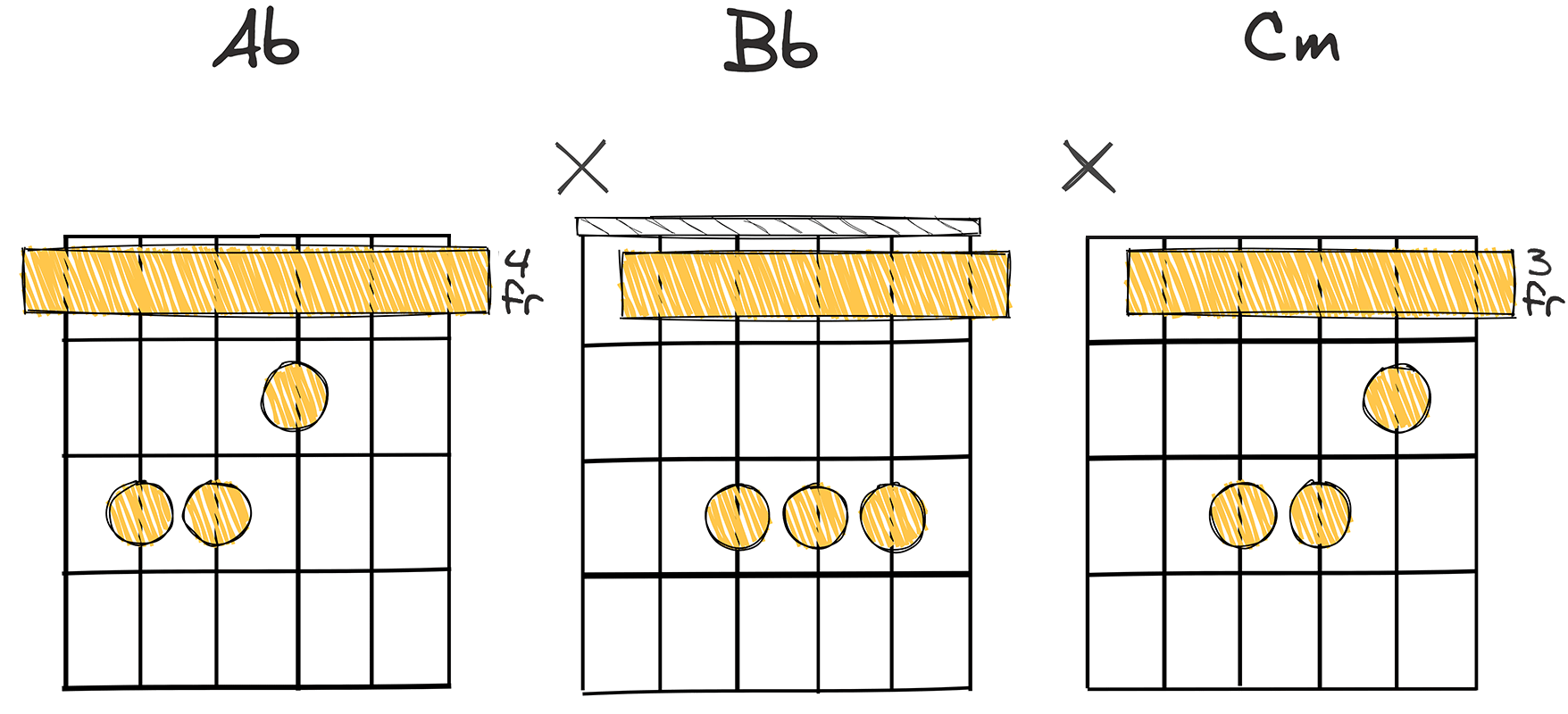
One of the primary reasons this progression generates an eerie atmosphere is because it revolves around minor chords which are well known for their melancholic or ominous tone.
This specific progression walks the listener upwards in the scale, building tension as it moves forward.
An important aspect of this chord progression; its relative ease of play for intermediate level musicians; making it accessible yet deeply evocative.
The progression’s inherent versatility and adaptability also allow musicians to experiment with the progression to create their own unique and haunting melodies.
The quoted sentence highlights the flexibility of this chord progression.
Its relatively simple structure provides a strong basis for various musical experiments.
This attribute makes it an excellent learning tool for intermediate musicians who are perfecting their skills.
The ominous atmosphere that the VI – VII – i progression creates is not only limited to modern music genres such as rock and pop.
Historically, this chord progression has been used in various types of music, from classical compositions to contemporary songs, adding an element of mystery and suspense.
It’s often found in genres like blues, jazz, and even in elements of flamenco.
It’s ubiquity attests to its timeless eerie appeal and adaptability across a wide range of music styles.
When played on the keyboard or a guitar, the VI – VII – i progression’s somber tone can be quite captivating; enabling the musician to draw the listener into their dark musically themed narratives.
Adding variations to this base chord progression can substantially alter the mood of the song, adding layers of complexity and depth to the music.
Skillful manipulation of this progression can result in captivating melodies that leave the listener entranced.
Not only this, but this chord progression can also serve as an excellent building block for young musicians looking to establish a strong foundation in their chord progression knowledge.
iv – VI – vii° (4-6-7)
Embrace the unexpected with this haunting yet captivating progression.
The iv – VI – vii° chord progression utilizes the fourth, sixth, and seventh chords in a minor key to create an intense, haunting ambiance. Combining these somber notes can give your music a dark, eerie quality, making it perfect for suspenseful or dramatic pieces.
- Difficulty: Intermediate
- Example: Fm – Ab – Bdim (Key of C minor)
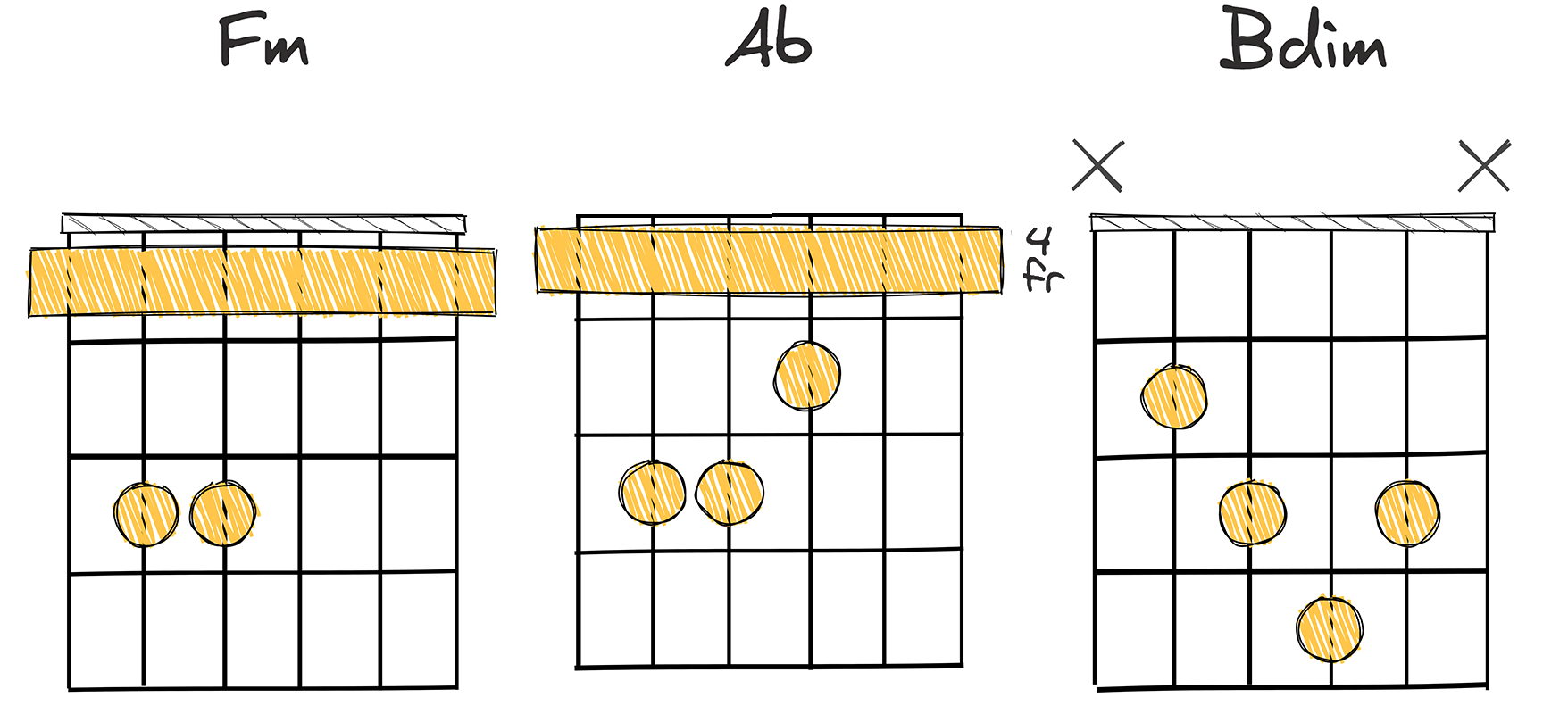
In the intriguing world of music compositions, one chord progression sequence that comes forward, imbuing songs with a thrilling aura, is the iv – VI – vii° (4-6-7) progression.
This memorable sequence has had its fair share of historical significance and held an intermediate complexity level to master on any instrument.
Deeper into the history of music, this unique chord progression held its ground and was frequently used by composers for its ability to add dramatic effect to a musical piece.
Be it the gothic orchestras of the 19th century or the modern rock bands, the IV – VI – VII° progression found its presence in narrative-driven compositions, augmenting the aesthetic value immensely.
Indeed, gothic and symphonic metal bands also frequently employed this chord progression, to instill a sense of awe and majestic darkness that is characteristic of their music style.
The dark and elusive nature of these chords is often coupled with their intermediate complexity, making them a rewarding challenge for many musicians.
Despite the intrigue that they inspire, the iv – VI – vii° progression isn’t particularly complex in itself and promises a haunting beauty once the nuances are mastered.
It involves a minor subdominant (iv), a major sixth (VI), and a minor seventh (viiº), with each individual chord imbuing the overall sequence with a delicious eeriness.
The subdominant iv chord, characteristically darker in tone, smoothly transitions into the major sixth chord, VI, marking the onset of a compelling auditory ride.
The piece de resistance of this progression, however, is the climactic minor seventh chord vii, which consolidates the suspenseful nature of the previously played chords.
This progression, with its intense sense of eeriness, offers limitless possibilities for composers to articulate their musical ideas, making it a beloved choice in the realm of dark music compositions.
VI – III – iv – ii° (6-3-4-2)
A haunting progression that marries the somber with the unexpected.
This chord progression includes a mix of major and minor chords that create a suspenseful, eerie feeling, perfect for creating tension in your music. The shift from VI to III sets an unexpected, dark tone, while the transition from iv to ii° adds an unsettling twist, making it an excellent tool for suspenseful or thrill-seeking musical pieces.
- Difficulty: Medium
- Example: Ab – Eb – Fm – Ddim (Key of C)
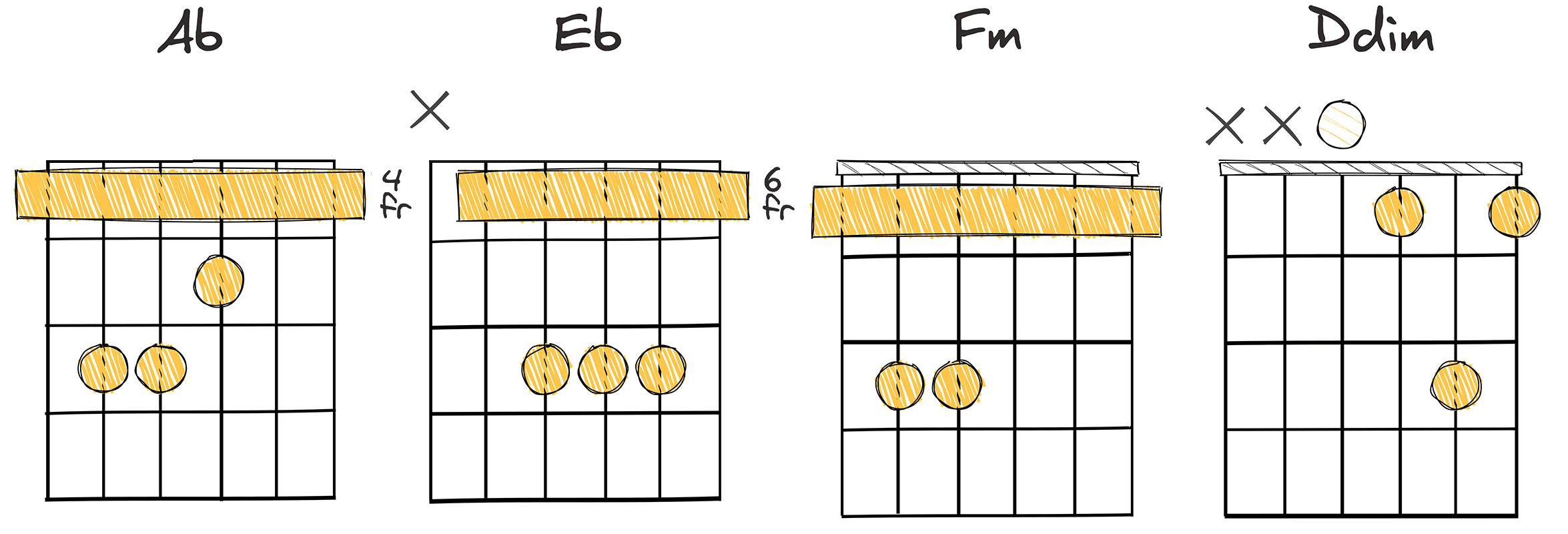
The VI – III – iv – ii° (6-3-4-2) chord progression provides an ominous, dark feel that can give your music an eerie edge.
Apart from having an intimidating ambiance, these dark chord progressions are medium in terms of skill level. As such, they require a moderate level of proficiency in the instrument to play effectively.
Historically, the VI – III – iv – ii° progression has been a staple in the world of classical music. It’s often used to convey a haunting or melancholic feel in a composition.
The root of this progression, the VI chord, is a minor chord, which instantly sets a somber tone for the song.
This minor root is followed by the III chord, which serves to amplify the progression’s brooding feel.
Adding on to the quote above, the shift to the III chord intensifies the song’s dark tone because it is another minor chord.
The transition from the VI to the III chord enhances the progression’s melodramatic nature, thereby amplifying its overall melancholy ambiance.
The iv chord which comes next, changes the dynamics and feel of the progression.
This minor chord adds an extra layer of sadness or longing into the mix, further deepening the eerie atmosphere of the music.
The final chord in this progression, the ii° chord, is a major chord.
Although it is a major chord, the II chord does not lift the dark cloud cast by the preceding minor chords.
Instead, it sustains the somber mood indelibly, keeping the listener immersed in the song’s haunting environment.
While this progression may seem basic from the outside, novice musicians might find it challenging to navigate due to the stark shift in mood entailed by moving from minor to major chords..
Whether it’s used in a piece of classical music or in a rock song, this progression can infuse your music with an atmospheric and eerie mood.
Furthermore, its historical significance in music and its medium skill level make it an accessible yet profound progression for musicians to experiment with.
For those looking to incorporate a darker, more dramatic feel into their music, this chord progression is a tried and true method to achieve that goal.
i – v – VI – III (1-5-6-3)
A haunting harmonic journey invoking uncanny suspense and subtle dread.
The i – v – VI – III chord progression yields a dark, haunting melody, often used in creating suspenseful and eerie sounding music. It sets a moody tone by starting on the minor root, shifting to the minor v chord, before knocking up to the major VI and ending with a significant deviation on the major III chord.
- Difficulty: Intermediate
- Example: Cm – Gm – Ab – Eb (Key of C Minor)
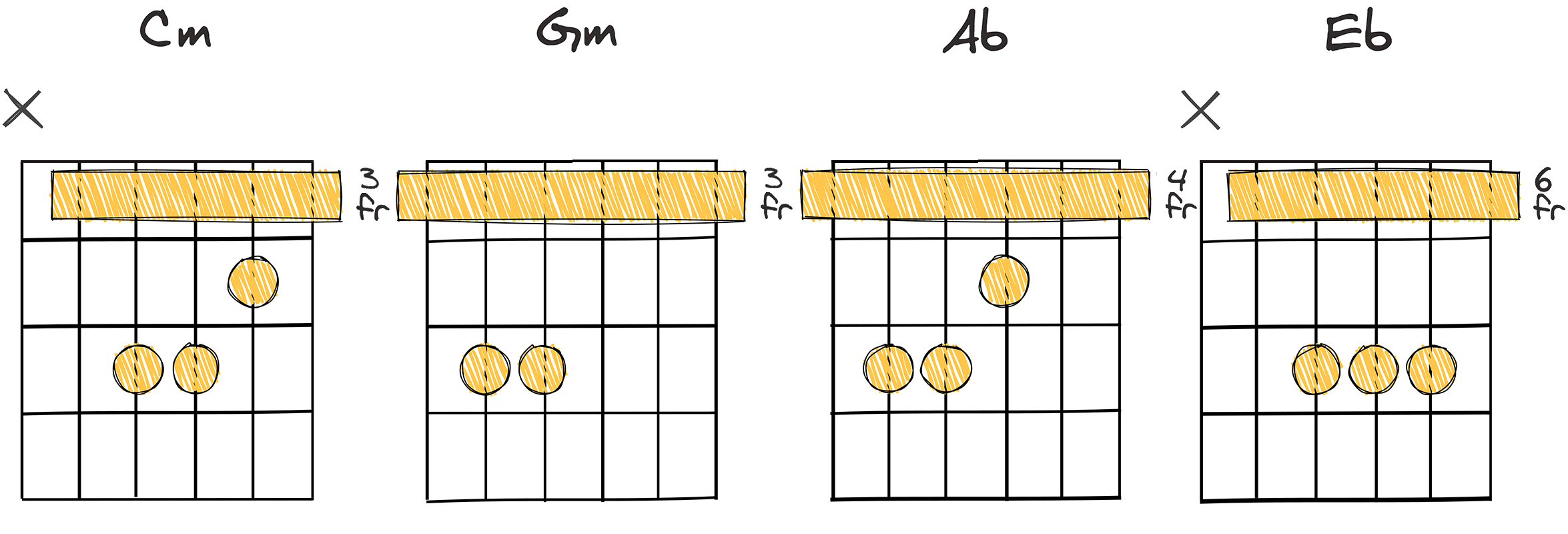
In the realm of music theory, chord progressions are defined as a succession of musical chords.
Each progression has a distinct sound that can alter the emotion and narrative of your composition.
Particularly, if you dwell in the dark and eerie, the i – v – VI – III (1-5-6-3) chord progression could be your ideal tool.
What makes this progression different from others is its use within popular music culture.
Used less often than other minor chord progressions, it creates a unique, haunting atmosphere.
This bold departure from the norm can help your music to stand out.
While the progression may seem complex at first glance, it is classified as intermediate difficulty.
The progression involves C minor (i), G minor (v), A flat (VI), and E flat (III), in the key of C minor.
Therefore, one needs to be familiar with the basic chords and transformations of chords within a given key, in order to execute it with ease.
With a bit of practice, even someone new to songwriting or composition, can potentially use this progression to infuse their music with an eerie, haunting feel.
This quote captures the essence of this discussion, stressing the accessibility of this chord progression for composers of various skill levels.
Even as a novice, understanding and applying this chord progression within your own compositions can completely alter their emotional impact.
Its historical origin is not very clear, however, the i – v – VI – III progression has gained attraction over the years especially in the genres prone to darker, more melancholic music.
Musicians and composers across various genres have used this progression to create a particular mood in their music.
Moreover, it’s important to remember that while this progression may seem dark and eerie, context is key.
Different elements such as tempo, instrumentation, and lyrical content can dramatically alter the way the progression is perceived by the listener.
For anyone seeking to create an eerie, haunting atmosphere in their compositions, this chord progression could be a powerful tool.
Keep in mind, it’s not about using something simply because it’s unusual, but about gaining a strong understanding of the progression’s nuances and how best to incorporate it into your work.
Depending on your musical style and the emotional narrative you wish to portray, this chord progression could provide the eerie edge you’ve been seeking.
By deeply understanding and incorporating these chord progressions into your music, you can transform your compositions into haunting masterpieces.
Therefore, do not shy away from exploring the depths of the i – v – VI – III chord progression and unleash the potential of this powerful sequence in your compositions.
Remember, it is through the experimentation and application of these unusual chord progressions that you’ll be able to find your unique voice in the realm of music composition.
ii – V – I (2-5-1)
This haunting 2-5-1 progression sculpts an ethereal, spine-chilling atmosphere.
The ii – V – I (2-5-1) progression delivers a haunting, moody ambiance, serving as a popular choice for those looking to imbue their music with an eerie edge. This progression is noted for its rich, dark tonality, often utilized in genres such as jazz, blues, and even rock to evoke strong emotions in listeners.
- Difficulty: Intermediate
- Example: Dm – G – C (Key of C)
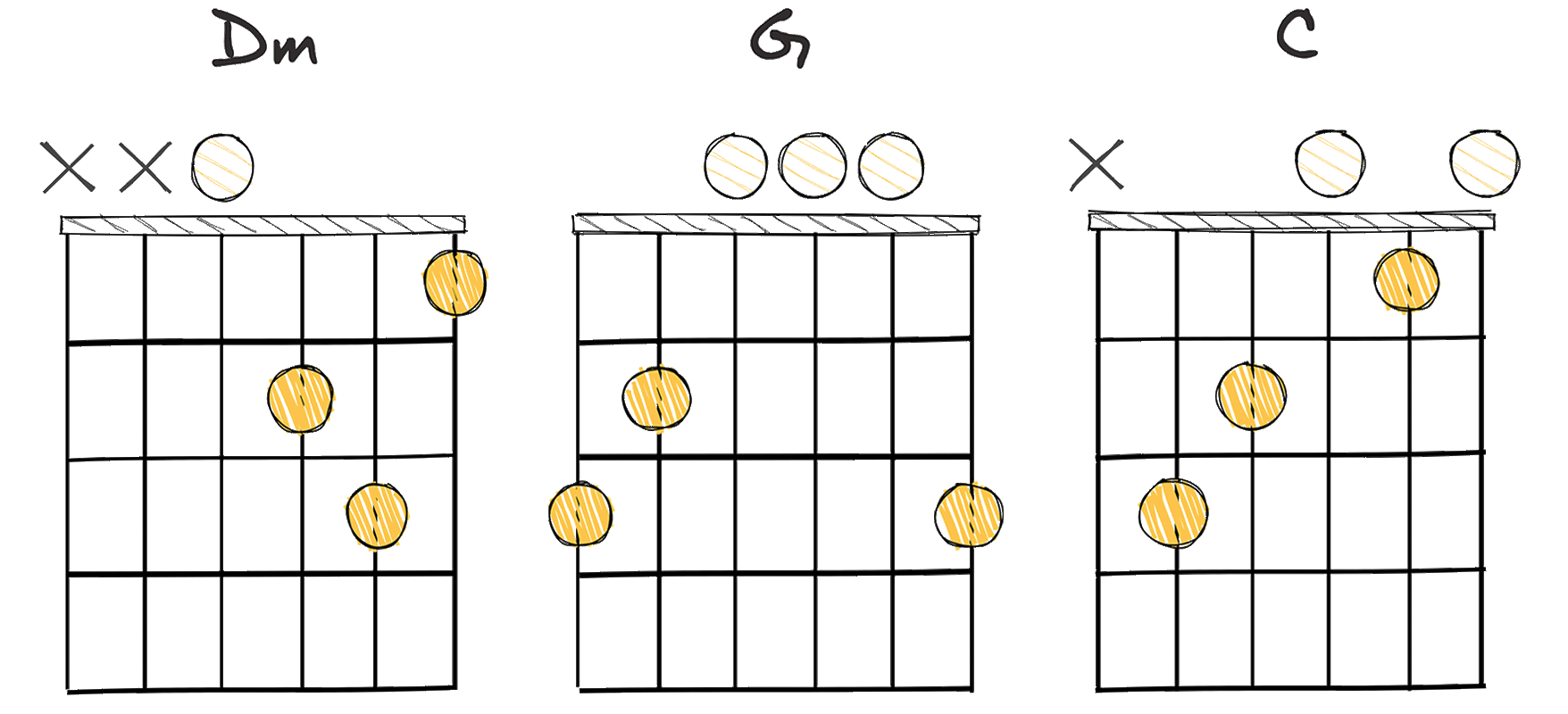
The chord progression ii – V – I (2-5-1) employs the use of dark tones, creating a sense of mystery and suspense within a composition.
This sequence, more commonly referred to as a 2-5-1 progression, is a fundamental staple in modern music, particularly in genres such as jazz and pop.
Historically, the 2-5-1 progression dates back to the Baroque period, where it was often used as a basis for improvisation in various music pieces.
It is well known for its versatility and ability to adapt to a variety of harmonic contexts, while also providing an eery edge to a melody.
This melodic ability stems from its inherent tension and release cycle, with the ‘ii’ and ‘v’ chords building tension, and the ‘i’ chord providing the much-needed resolution.
When applied in the context of dark music, this progression can deliver a gloomy and melancholic atmosphere.
The intermediate level of this progression lies in the ability to manipulate its chords to match a specific mood or atmosphere within a composition.
It’s not always straightforward to transition smoothly between the chords in this progression, especially for those who are new to dark music genres.
Advanced usage of this progression may involve including chord substitutions or alterations like tritone substitutions, diminished chords or augmented chords to spice things up.
Integrating octave changes, such as playing the ‘V’ chord an octave higher, can enhance the overall tension of the progression.
This chord progression’s power to stir intense emotions is one of the reasons why it remains a favorite choice for many musicians aiming to evoke a dark or eerie mood.
i – iv – VII – III (1-4-7-3)
A haunting progression casting shadows of melancholy and intrigue.
This progression, often known as the “I-iv-VII-III” sequence, incorporates dark and somber chords to create a haunting atmosphere for a song’s harmonic landscape. Shifting from the tonal center to minor chords and unusual transitions, it adds an eerie, unsettling element to music, making it ideal for genres looking to evoke a sense of mystery or tension.
- Difficulty: Intermediate
- Example: Cm – Fm – Bb – Eb (Key of C Minor)
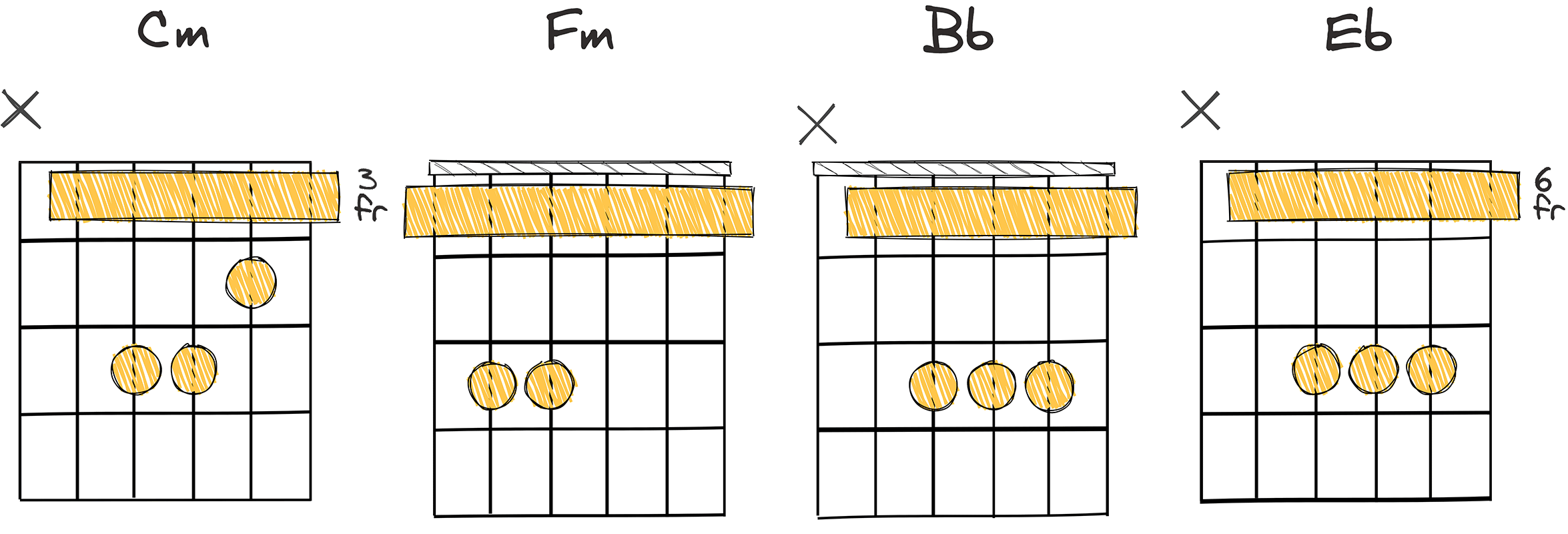
For those wishing to delve into the world of unforgettable, eerie, goosebump-inducing sonics, one must venture into the realm of dark chord progressions.
Today, we will examine one of these progressions in depth, focusing on an intermediate level progression: “i – iv – VII – III”.
This progression, translated into the key of C minor, becomes “Cm – Fm – Bb – Eb”.
Dark chord progressions such as this one often involve minor chords and chromaticism, where notes or chords are used outside of the key signature.
The contrast between these chords generates tension, a critical tool in music composition.
It is safe to note though, that advanced, eerie and haunting doesn’t mean music composed with this progression is limited to rock or metal genres.
The said progression can also be found in numerous classical pieces and film scores, especially in scenes that depict tension, mystery, and suspense.
Hans Zimmer, a prolific composer best known for his work on blockbusters like ‘Interstellar’ and ‘Inception’, often uses this progression.
Moreover, ‘Bela Lugosi’s Dead’ by Bauhaus, a classic Goth rock track from the late 70s, also uses the “i – iv – VII – III” progression.
In fact, this progression frequently appears in the music of those genres that encapsulate dark, brooding moods.
It appears dominantly in many Goth, Rock, Metal, and EDM productions, to name a few.
Historically, composers have been using these progression principles for centuries.
The effectiveness of chord progression sequences in evoking certain emotions is rooted deep within music theory.
Structuring notes and chords in a particular order can present a flow of music that is unique yet dramatic in its delivery.
This uniqueness is a fundamental characteristic of dark chord progressions like “i – iv – VII – III”.
A peculiar thing about the analyzed progression is that it seems relatively simple, but the emotions it can convey are overwhelmingly complex.
That is the reason why many artists and musicians gravitate towards employing it in their compositions.
With the right execution, this chord progression can be a powerful tool in a musician’s toolbox – whether they’re looking to instill unease, suspense, or outright fear in their listeners.
It is a testament to the emotive power of music, and its limitless potential for expression.
I – vi – IV – ii (1-6-4-2)
A brooding progression evoking enigmatic shades and haunting emotion.
This chord progression, moving from I to vi to IV to ii, offers a haunting and suspenseful journey that evokes a sense of ominousness and foreboding. The specific movement is ideal for eliciting emotions of unease and tension, making it perfect for dark-themed music projects.
- Difficulty: Moderate
- Example: C – am – F – Dm (Key of C)
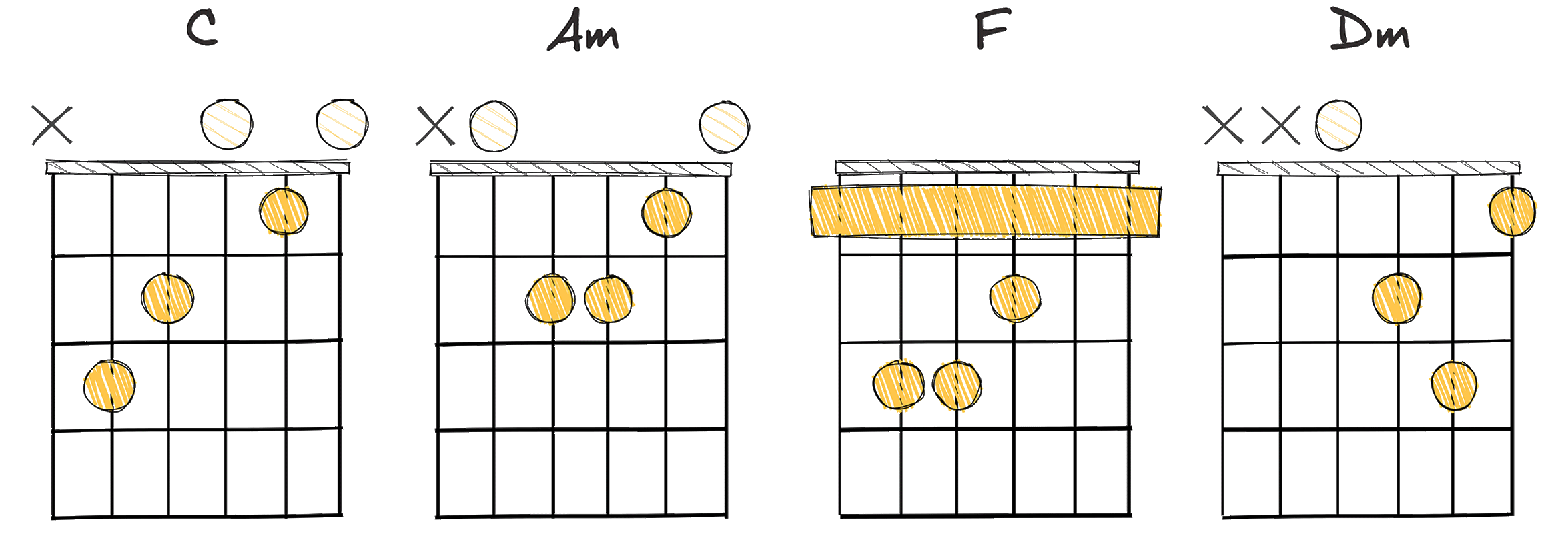
The chord progression I – vi – IV – ii (1-6-4-2) in the key of C major converts to C Major – A Minor – F Major – D Minor, a beautiful melancholic progression well suited for creating an eerie musical atmosphere.
The roots of this progression can be traced back to the classical music era, where it was used to create a subtle shift from light to darkness within a piece of music.
“Such chord combinations depart from typical major key progressions to subtly infuse a composition with a distinct eeriness, characteristic of a minor key.”
This quoted insight underlines the power of this chord progression in transforming any composition’s mood.
The chord change from C major to A minor, for example, illustrating this transition from cheerfulness to melancholy.
Further, the transition from A minor to F major and then to D minor carries forward this narrative, reflecting a downward trend in mood, and the D minor reinforces the haunting undertone.
When it comes to playability, this progression is considered moderate and holds immense potential for creating unique tunes.
The simplicity of this progression, coupled with its emotional depth, has perhaps contributed to its popularity in music creation.
Musically, the I – vi – IV – ii progression’s versatility lies in its capability to be used in various music genres, stamping a dark mood on each piece it’s applied to.
This progression has stood the test of time in providing songwriters with a tool to weave complex emotional narratives through their music.
The legacy of the chord progression I – vi – IV – ii is a testament to music’s endless capacity to evoke profound emotion and its significance as a bridge between the artist’s intent and a listener’s perception.
In the context of creating eerie or melancholic music, the utilization of this chord progression can act as a powerful vessel to carry a song’s emotional weight.
Understanding the dynamic relationship between different chords and the emotions they can uncover is vital for any songwriter who aspires to craft nuanced and emotionally stirring music.
Knowledge of chord progressions, such as this one, is indispensable to contemporary songwriting and composition.
Further exploration of these fascinating patterns promises to expose anyone willing to delve deeper into the language of music’s unexplored depths.
IV – V – I (4-5-1)
A hauntingly suspenseful descent into comforting resolution.
The IV – V – I progression, also known as the 4-5-1, provides a dark and brooding tone to a musical piece, adding an air of mystery and suspense. Its progression from a minor subdominant (iv) to major dominant (V), ending in a satisfying tonic (I), has the power to create an eerie and fascinating sonic journey.
- Difficulty: Easy
- Example: F – G – C (Key of C)
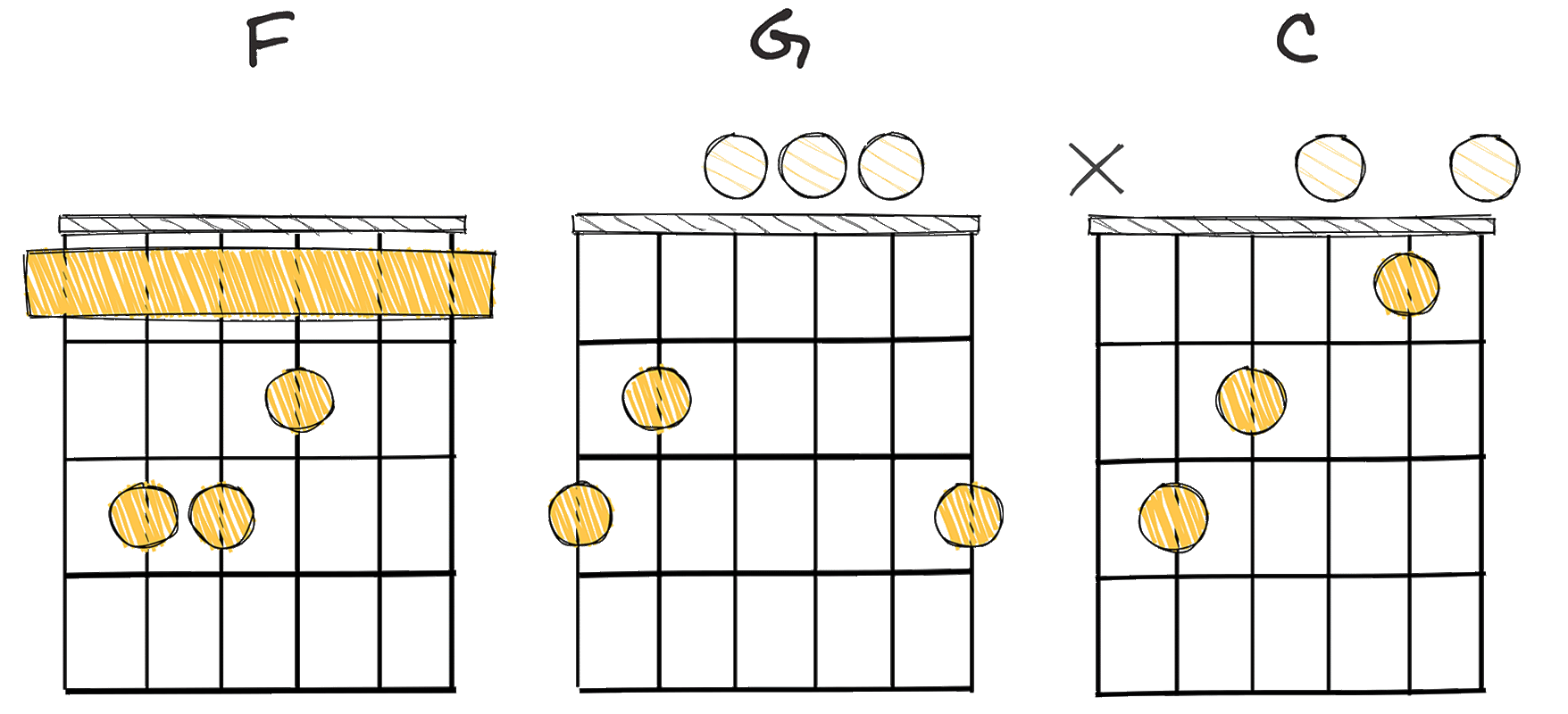
The chord progression IV – V – I (4-5-1) , which translates in the key of C to the chords F – G – C, is a masterful choice for musicians looking to infuse their compositions with a hint of darkness and intrigue.
It’s the following resolution to the major I chord (in this case, C) that delivers an unexpected twist, balancing the previous tension with a sense of finality, albeit one drenched in complex emotion.
This is especially true in the context of dark, evocative genres such as gothic rock, doom metal, and some forms of electronic music.
Using the IV – V – I with expertise can take listeners on a haunting journey through gloomy valleys and peaks of tension.
However, despite the intense emotional narrative that this chord progression can support, it is surprisingly easy to play.
The shared notes between the three chords allow for comfortable transitions on many instruments.
Not only is this appealing for amateur musicians exploring new sonic territories, but it also allows more advanced players to experiment with inversions and voicings to further deepen the dark atmosphere.
The IV – V – I chord progression has a rich history in music.
Although typically associated with the classic blues genre, where it contributes to a sense of melancholic yearning, it has also been harnessed by musicians across a spectrum of genres.
From the brooding ballads of post-hardcore bands to the ethereal soundscapes of ambient electronica, the 4-5-1 chord progression has provided a reliable foundation for countless memorable tracks.
In this seminal metal track, the progression underscores the song’s themes of despair and resignation, amplifying the poignancy of the lyrical content.
Through its expert use, Metallica demonstrates how a simple triad progression can be transformed into something profoundly powerful.
The IV – V – I progression is ultimately a musical tool for artists, allowing them to express complex emotional landscapes with relative simplicity.
And when executed effectively, this progression can take listeners on a haunting journey, traversing tension, resolution, and a pervading sense of eerie foreboding.
i – ii° – VII (1-2-7)
Unleashing ominous tension, this progression thrives on unsettling musical journeys.
This i – ii° – VII (1-2-7) progression creates a dark, haunting, and somewhat uneasy tonal ambiance due to its unusual composition. With the shift from the tonic minor to the major second and then a jump to the major seventh, it is sure to introduce an eerie, suspenseful vibe into your music.
- Difficulty: Medium
- Example: Cm – Ddim – Bb (Key of C minor)
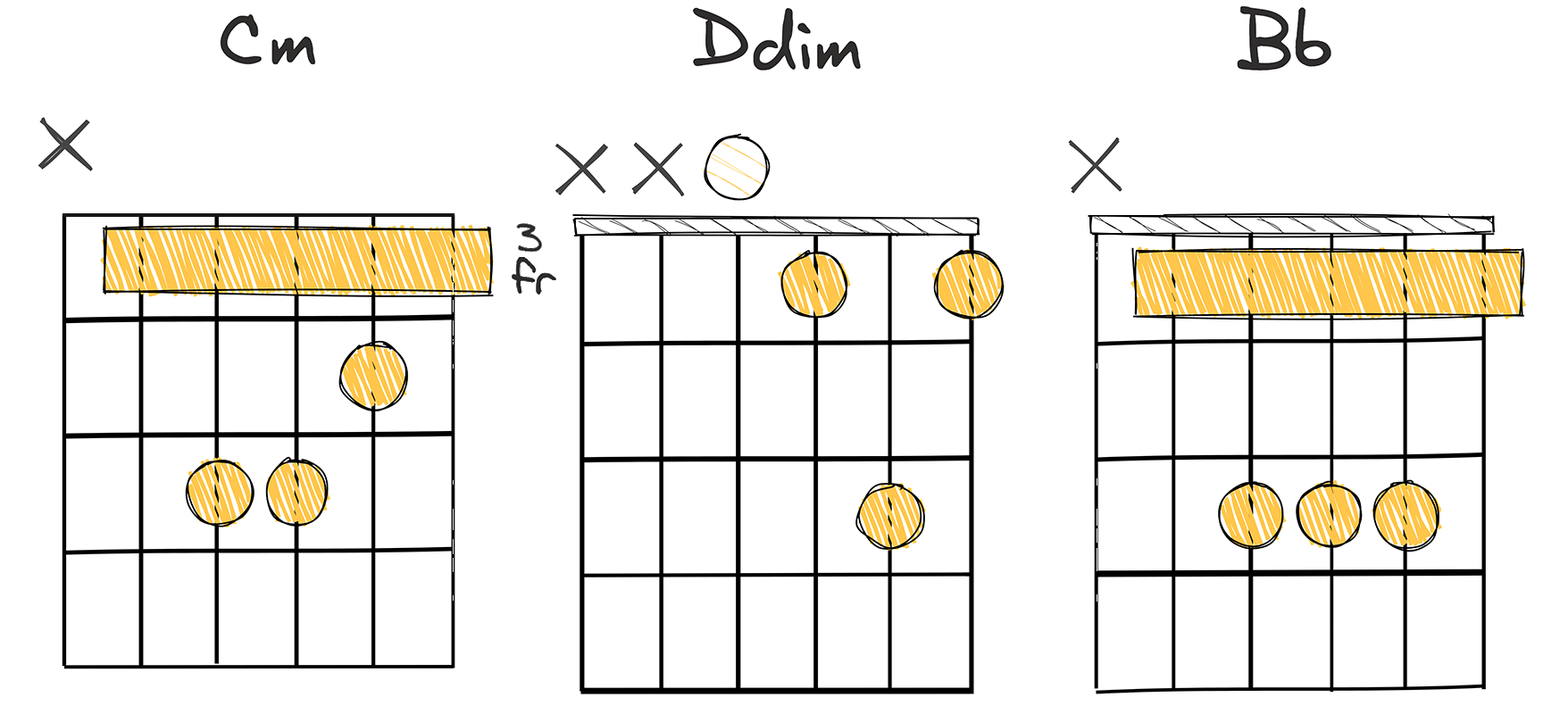
One of the most hauntingly beautiful dark chord progressions in music is i – ii° – VII (1-2-7), or in the specific key of C minor, this translates to C minor (i) – D diminished (II) – Bb Major (VII).
This progression, while not overly complex, offers a deep and emotional soundscape that lends itself significantly to darker, more melancholic music.
The most intriguing aspect of this progression, is the transition from a minor chord, to a diminished chord, and then finally to a major chord.
This dynamic journey through different chord types provides a stark contrast and narrative to the music, making it exceptionally effective in conveying emotion.
The use of the diminished chord, in this case D diminished, acts as a pivot point in the progression, creating a bridge between the C minor and Bb Major, and injecting an eerie tension into the music.
Diminished chords have a dissonant sound that can cause unease or suspense, and when placed in between a minor and major chord, they can intensify the emotional release that comes with the resolution to a major chord.
The choice of the Bb Major as the final chord in the progression is also noteworthy.
This chord completes a round trip back to the root note, C, offering a sense of resolve and completeness but still maintaining an element of sadness due to the initial key being minor.
From a historical standpoint, this progression has been used most extensively in film score composition to elicit strong emotional responses from the audience.
Its prevalence in cinema showcases the significant potential of this progression to create tension and release in an awe-inspiring way, illustrating its capability to make people feel profoundly.
Nevertheless, it’s important to note that while this progression has much potential, it’s also medium in terms of difficulty to play, especially for beginners.
The transitions between the chords can be a bit tricky, especially the one from the D diminished to the Bb Major, but with continuous practice and understanding of the underlying theory, it becomes quite manageable.
When used with thoughtful intention, the i – ii° – VII (1-2-7) progression can infuse your music with a menacingly beautiful and evocative sound, that pierces through to the core of human emotion.
Its power to immediately create an atmosphere of melancholy, mystery and tension is part of what makes this progression a popular choice for composers who want to give their music an eerie edge.
ii – vi – V (2-6-5)
This progression creates a haunting, ambiguous undertone for compositions.
The ii – vi – V chord progression provides an intriguing mix of minor and major tones, creating a dynamic, yet somber sonic landscape ideal for evoking emotions of melancholy or unease. This unusual combination destabilizes expectations, leading the listener onto a path less predictable, resulting in a captivatingly eerie edge in the music.
- Difficulty: Intermediate
- Example: Dm – Am – G (Key of C)
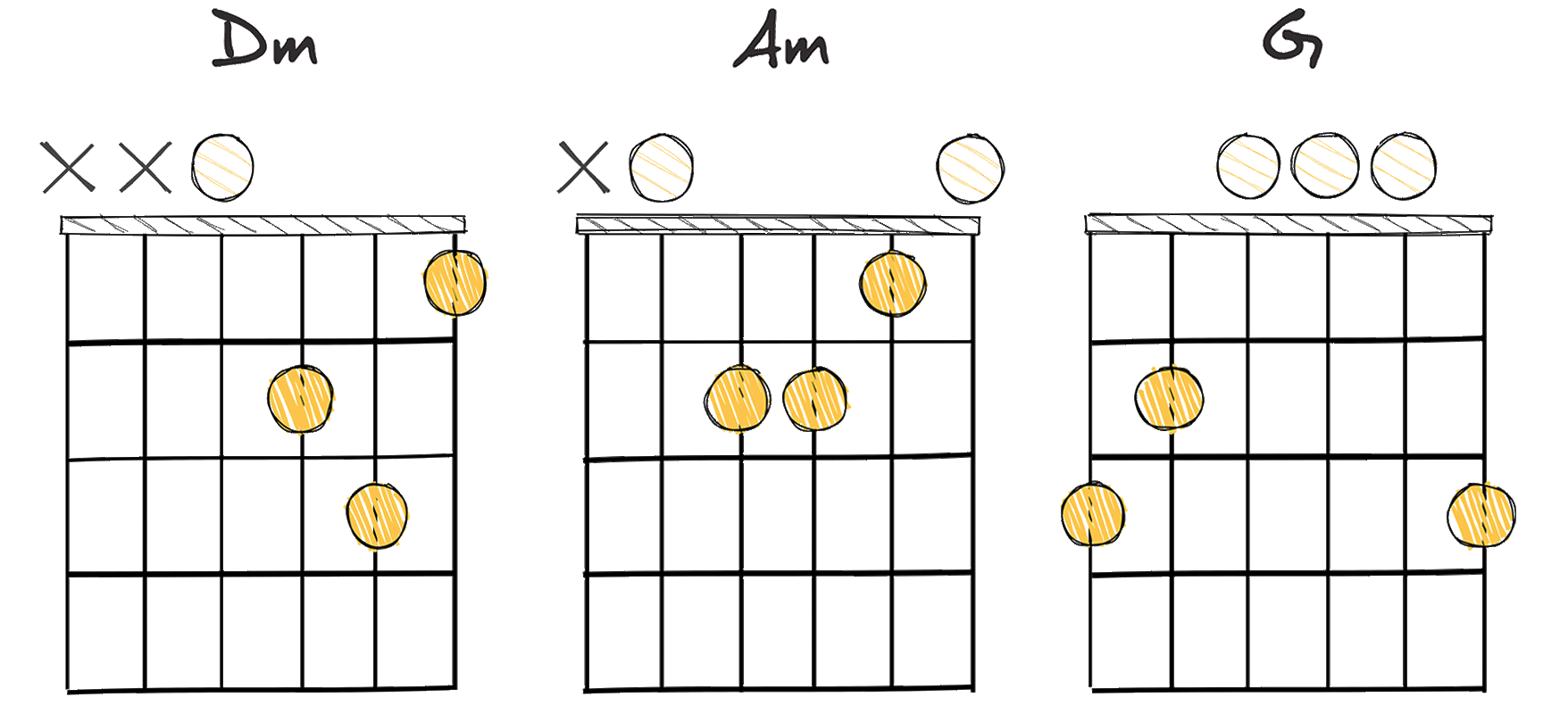
The ii – vi – V (2-6-5) progression is one of the commonly used chord progressions that can give your music an eerie, dark edge.
Falling within the key of C, the chords for this progression are Dm – Am – G.
Classified as an intermediate level progression, it requires a certain level of skill and understanding of chordal relationships to be played effectively.
The ii – vi – V progression has an intriguing history.
Often coined in many classical and contemporary pieces, its popularity arises from its capacity to convey suspenseful and disheartening emotions.
As backing to the previous statement, it’s crucial to note that this progression’s emotional resonance has made it a favorite among composers seeking to evoke a certain level of tension or melancholy in their compositions.
As a musician or composer, mastering this progression is not only crucial for your skill development but also for expanding your musical vocabulary.
Given its emotional weight and flexibility, the ii – vi – V progression is a valuable tool in the toolkit of any composer or songwriter.
Specifically, in horror or suspense genres, this chord progression can create a strong atmosphere of tension and apprehension.
Mastering and incorporating the ii – vi – V chord progression in your compositions can provide an effective means of creating music with a dark, eerie edge.
Whether your goal is to create a suspenseful film score or a melancholic rock song, understanding this progression and its applications is key.
The ii – vi – V progression is undoubtedly a testament to the transformative power of music and its capacity to evoke the deepest of emotions.
Remember, mastering this progression can open a world of possibilities and pave the way for more creative adventures in your music journey.
VI – vii – I (6-7-1)
This progression invokes an ominous, haunting ambiance within your compositions.
The VI – vii – I progression is a unique melodic sequence that delivers a sinister and foreboding tonal outcome. It’s an effective tool for musicians aiming to inject an eerie, ominous touch into their compositions, allowing them to create an immersive and dark atmosphere.
- Difficulty: Easy
- Example: F# – G#m – A (Key of A)
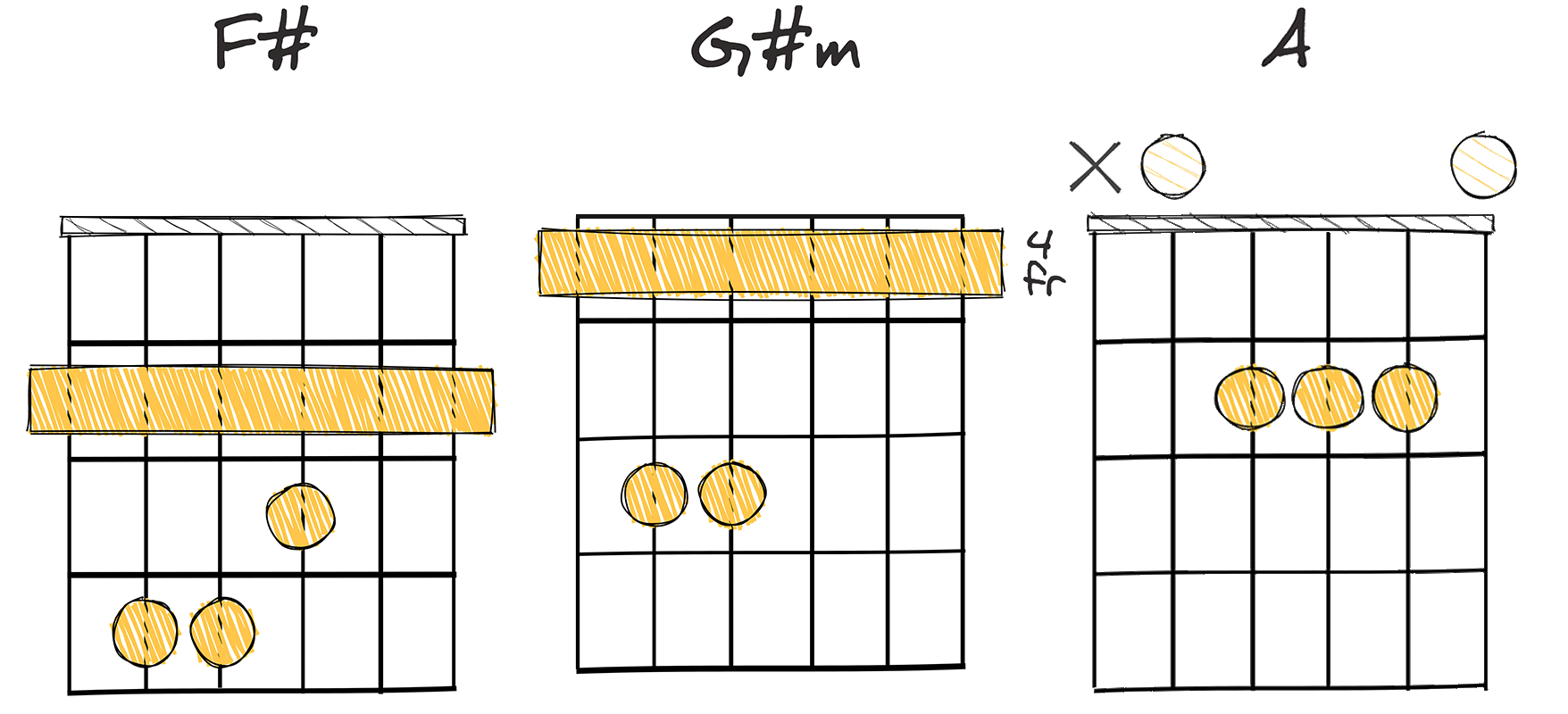
The VI – vii – I (6-7-1) chord progression is a relatively simple yet versatile sequence that’s no stranger to contemporary music, honing its particular quality of melancholy.
Its simplicity facilitates easy understanding for both beginners and advanced musicians alike, as it only involves three chords.
This progression is ascribed with the ability to create an eery, somewhat “haunted” ambience.
The inherent minor tones in the VI and vii chords, coupled with the resolving tone of the major I chord, blends together to create that gloomy, mysterious air
As stated, the progression’s power derives from the interaction of its minor and major chords.
The VI and vii, both inherently minor, instil an air of gloom and suspense.
Following those eerie notes is the I chord.
Acting as a major key, it works mostly to resolve the lingering tension, but with a tinge of sorrow left in its wake, keeping intact the progression’s dark edge.
Thanks to its versatility, this progression is a common choice in various music genres, primarily serving to emphasize sentimental, melancholy, or eerie themes.
The chords’ arrangement, rhythm, and instrumentation can also significantly affect the mood it sets.
Nevertheless, the VI – vii – I progression’s ability to evoke a hauntingly beautiful ambiance has solidified its place within the music world, particularly within darker musical pieces.
Regardless of one’s musical expertise, mastering this chord sequence could undoubtedly improve one’s music repertoire, especially when seeking to inject a sense of mournful mystery into a composition.
Ultimately, while the VI – vii – I chord progression is straightforward to play, its ability to express a range of profound emotions is what fuels its ongoing popularity within modern music.
As musicians continue to explore and experiment with this chord sequence, we can anticipate the emergence of even more eerie, hauntingly beautiful songs gracing our ears in the future.
iv – ii° – i (4-2-1)
A somber descent into hauntingly beautiful, mysterious melodies.
The iv – ii° – i chord progression, also known as 4-2-1, generates a deep, mysterious, and suspenseful aura, making it perfect for setting an eerie tone. This particular progression, moving from the subdominant minor to the supertonic minor and ending on the tonic minor, creates tension, resolution, and a haunting mood that can truly captivate your listeners.
- Difficulty: Intermediate
- Example: Cm – Adim – Gm (Key of G minor)
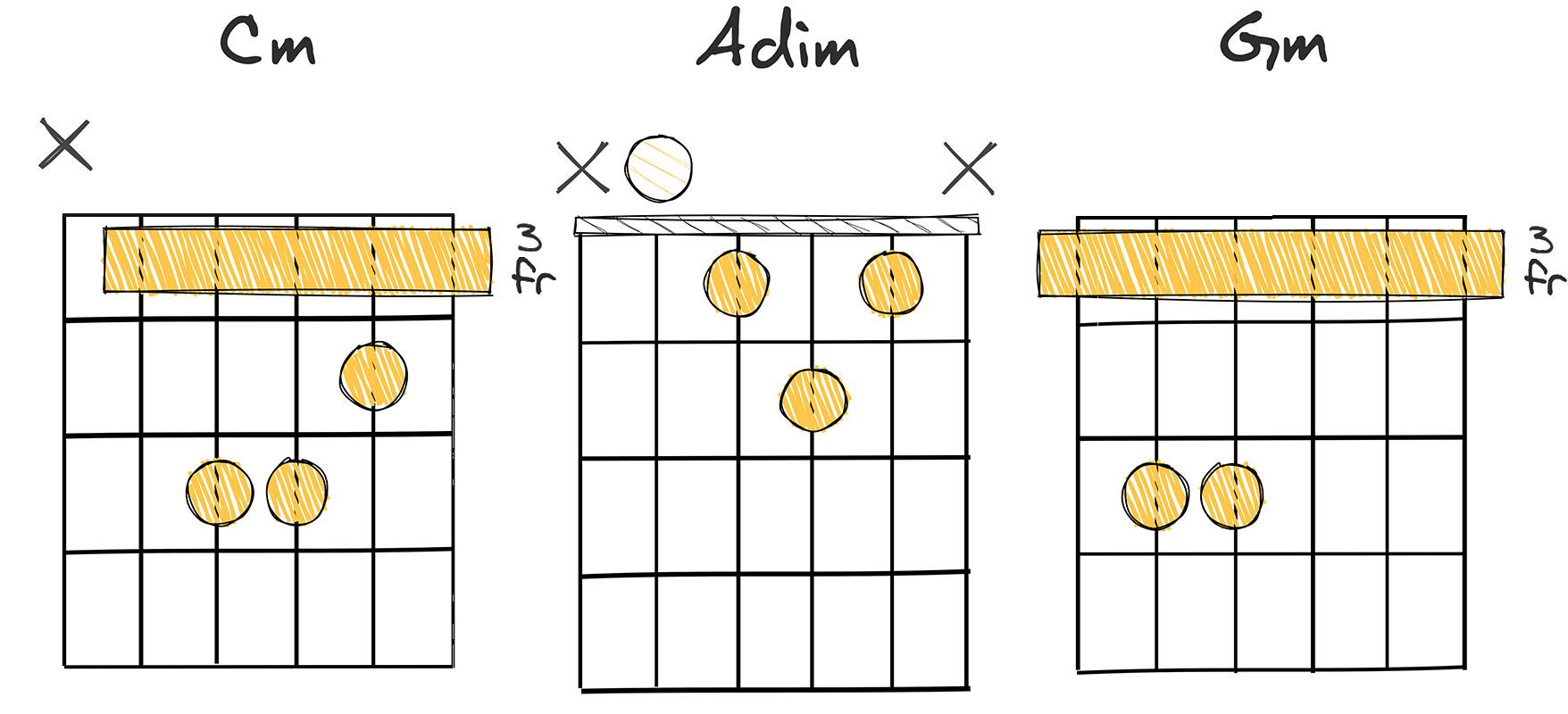
Delving into the intriguing world of dark chord progressions, the iv – ii° – i (4-2-1) sequence holds a unique position that instantly adds an eerie edge to your music.
While its quintessential gloom can be found resonating through countless compositions, this three-chord progression has an intriguing history of its own.
Historically, the use of these chords can be traced back to the classical music period where composers began to experiment with minor keys to evoke deeper and more complex emotions in their listeners.
The iv – ii° – i (4-2-1) progression, commonly found in an intermediate level of difficulty, has the power to provide an enchanting dissonance to your music.
This chord progression’s exclusive dissonance, coupled with its ability to create an ominous atmosphere due to its minor key base, sets it apart.
A fine balance of three chords ties in a sense of closure, while the descending movement between the chords often insinuates a narrative of falling or sinking, often a recurrent theme in darker composition.
Moreover, the progression’s compatibility with different genres adds to its versatility.
Whether it’s rock, pop, or even soundtrack music, this progression fits in seamlessly while adding its unique touch of eery.
With practice, intermediate level musicians can efficiently include this progression in their compositions, creating an effective backdrop for measures that emanate a sense of gloom.
Indeed, the iv – ii° – i (4-2-1) progression is well within the grasp of musicians aiming to dabble with an unconventional, murky theme in their music.
It is incredibly fascinating how just three chords can induce such a profound impact on the overall mood of a composition.
As we continue to explore further, let’s remember that embracing the unconventional might just give your compositions the unique eerie edge they need to stand out.
i – VI – iv – v (1-6-4-5)
A hauntingly melancholic progression with a spine-chilling unresolved finish.
This chord progression, which moves from the first to the sixth, the fourth and then the fifth, carries a somber and haunting quality. It provides the framework for creating moody, melancholic soundscapes in a piece of music, evoking emotions of darkness, mystery, and tension.
- Difficulty: Intermediate
- Example: Em – C – Am – Bm (Key of E minor)
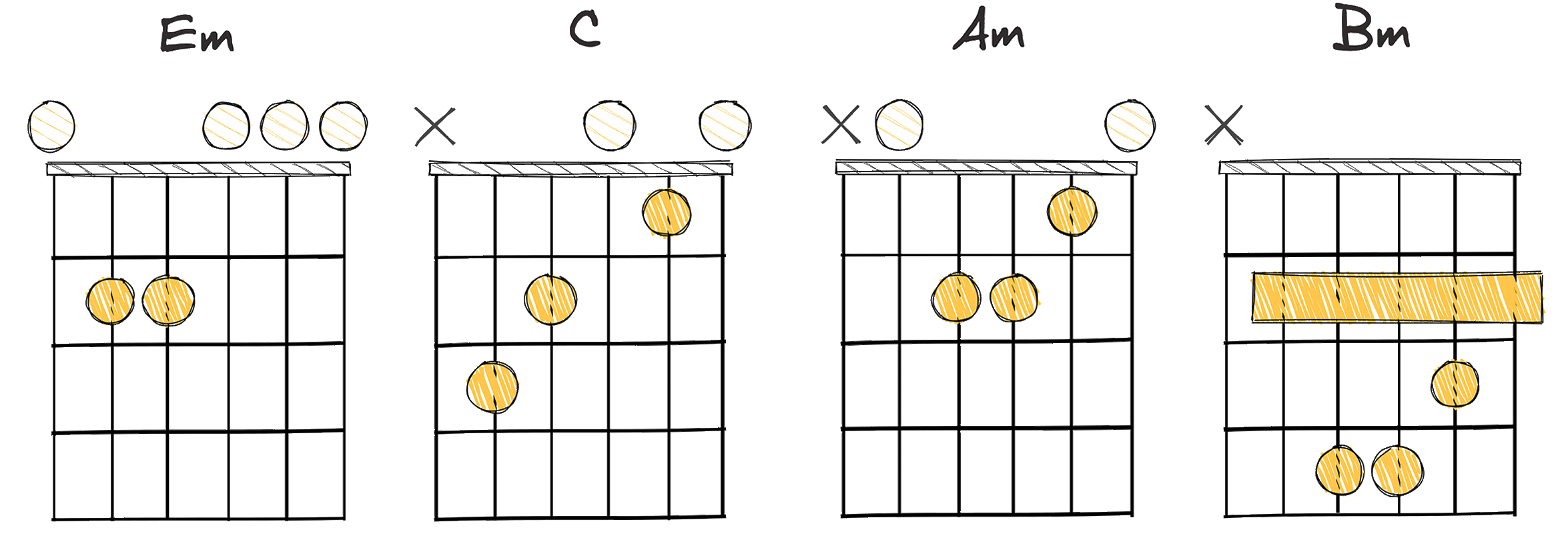
If you’re looking to bring an eerie edge to your music, dark chord progressions can do just that, and the progression of E minor – C major – A minor – B minor (Key of E minor) fits the bill.
Drawn from the standard i – VI – iv – v (1-6-4-5) progression, this particular set of chords may be canonically used in a minor key, which lends it that haunting, shadowy feel.
Over the years, this chord progression, despite being intermediate in complexity, has been used in a number of haunting songs, and is, therefore, instantly recognizable.
It must be noted that the deep melancholy undertone this chord progression brings to “Everybody Hurts” is what makes the song resonate with countless people worldwide.
What’s fascinating about this particular chord progression is that while it is intermediate in complexity, it still requires some skill to execute well and harmoniously.
It is the subtle shifts between the minor and major chords — between discord and harmony — that casts the truly eerie, haunting shadow over the music.
More so, the transition from E minor, which is naturally dark, to the brighter C major—followed by A minor and ending on B minor—creates an audible journey from light to darkness.
Such a progression envelopes listeners in an ominous soundscape, dragging them deeper into the song’s narrative.
Despite the eerie undertone, what really makes this progression a crowd pleaser is the musical tension it masterfully builds up and releases through the alternation of minor and major chords.
With each minor chord playing off the resounding major ones, it adds layers to the song while enhancing the music’s emotional depth.
The i – VI – iv – v progression is perfect for songs premised on conflict, struggle, or pain due to its inherent musical tension.
But above everything, it is how proficiently the musician manipulates this tension—dangling it before the listeners, stretching it to the limit and letting it go—that determines whether the song would make a chilling impact or not.
Yet, while the progression is quite popular and broadly utilized, every song that features it has its own unique interpretation.
It is precisely what makes this progression so captivating for both, the musician and the listener.
i – vii° – III – VII (1-7-3-7)
An ominous descent into an absorbing, spine-chilling harmonic journey.
This progression carries an invigorating, yet somber energy, beginning with a ‘home’ chord (i), sinking into a dark, brooding tonality (vii), before rising dramatically (III), and ending on an unsettling note (VII). Its unique blend of minor and major chords adds a mysterious and eerie edge to the music, making it an excellent choice for songs with dark or introspective themes.
- Difficulty: Intermediate
- Example: Cm – Bdim – Eb – Bb (Key of C minor)
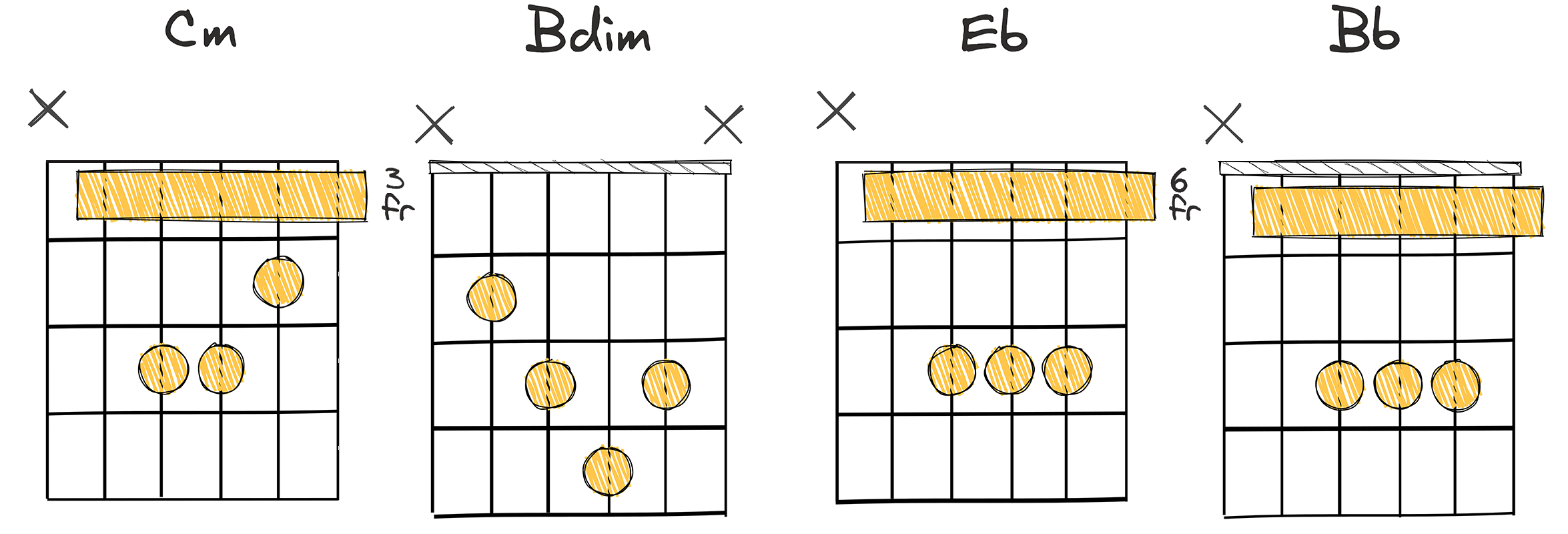
Intermediate level chord progressions, such as the progression of i – vii° – III – VII (1-7-3-7), can help musicians create dark, eerie undertones in their music.
These progressions tend to carry a strange and unusual resonance due to the incorporation of both major and minor chords.
Borrowing chords from parallel keys is a typical characteristic of these progressions.
This technique facilititates a melodic tension within the music, that has the ability to evoke strong emotions from listeners.
The B Diminished chord introduces an imposing tone of instability.
The abrupt shift in melody can provoke a feeling of discomfort and unease among listeners, hence reinforcing the eerie and mysterious vibe.
Furthermore, being an example of non-diatonic chord progressions, these sorts of sequences can offer a refreshing change of pace from traditional, diatonic progressions.
Chord progressions like these have been utilized by numerous musicians throughout the history of music.
The song’s melancholy mood is heavily attributed to its unconventional chord sequence.
Their unorthodox structure might seem challenging to learn to play such progressions.
However, they become more manageable with practice and are intermediate-level progressions.
These progressions demand a certain level of comfort and familiarity with chord building and chord relationships.
A basic understanding of music theory can be greatly beneficial when trying to master these progressions.
Pianists, in particular, can often find these progressions easier to play compared to guitarists.
The linear layout of the piano can sometimes provide a clearer visualization of the chord transitions.
The i – vii° – III – VII (1-7-3-7) progression can contribute greatly to creating music with a dark and mysterious edge.
It’s about understanding the fundamental dynamics of the chords and the distinctive tonalities they can produce when arranged in this manner.
Exploring such chord progressions can open up a vast array of new soundscapes for budding musicians.
They are a valuable tool for expanding your musical repertoire and architecting deeper, more enigmatic sound aesthetics.
i – IV – vii° – III (1-4-7-3)
An unsettling progression invoking sinister undertones with its unexpected turns.
This chord progression, moving from “i” to “IV” to “vii” to “III,” is characterized by its dynamic transitions, which can introduce a decidedly haunting or unsettling atmosphere to a musical piece. Its unique and non-standard structure allows for an intricate exploration of darker harmonies and tones, lending the progression a decidedly eerie yet captivating edge.
- Difficulty: Medium
- Example: Cm – F – Bdim – Eb (Key of C minor)
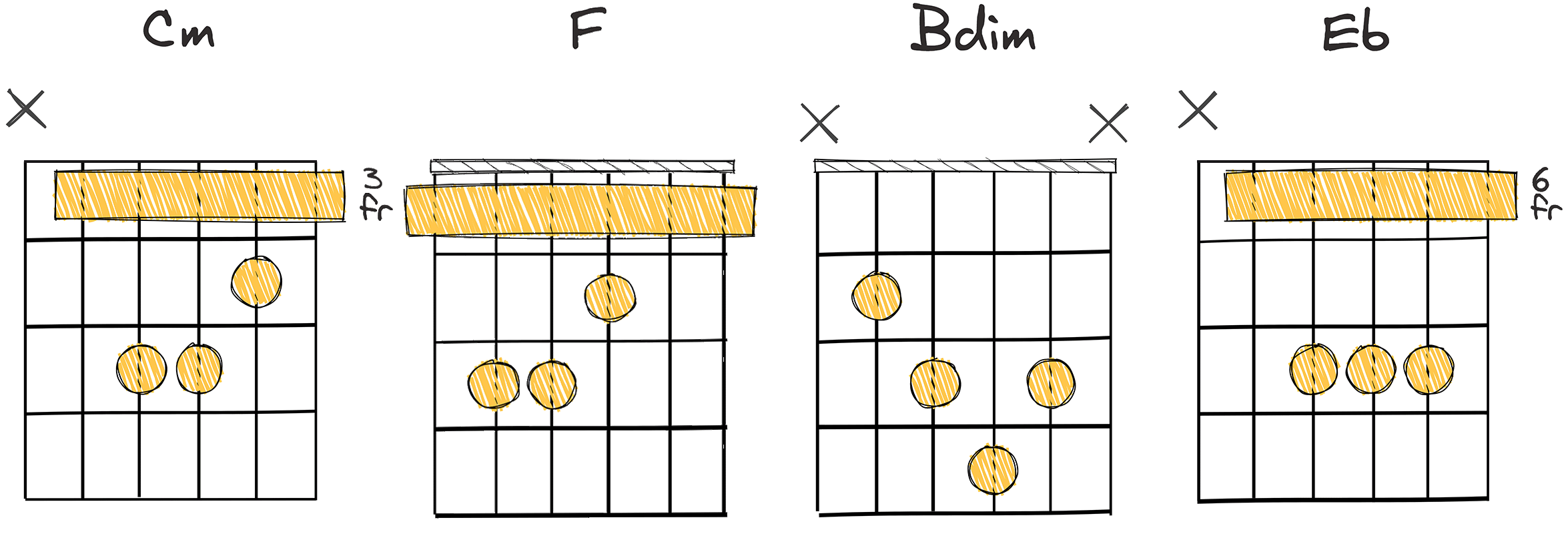
The chord progression of i – IV – vii° – III (1-4-7-3) presents a haunting melody that plays into the darkness of your music.
This is a compelling sequence that harnesses the intensity of the minor key to evoke a chilling narrative.
The Cm – F – Bdim – Eb progression (in the key of C minor) encapsulates an eerie darkness that is often explored in the realm of horror and suspense genres.
This progression creates a tension and unease that allows for emotional depth in your composition.
The theatrical effect produced by this progression makes it a popular choice among composers for creating ominous soundscapes.
An interesting historical tidbit about this sequence is its use in classical compositions such as Mozart’s Requiem, where it served to underscore dramatic moments and instill a sense of impending doom.
In more recent times, contemporary artists have also harnessed this progression to underscore the emotional depth of their lyrics.
The sheer versatility of the i – IV – vii° – III progression testifies to its potential in cultivating an eerie edge to your music.
The blend of suspense and introspection it offers can lend an engaging narrative to your composition, engaging the listener on an emotional roller coaster ride.
Understanding and experimenting with this progression can help you unlock new dimensions in your music, pushing you to create profoundly resonant pieces that leave an indelible impact on the listener.
vi – IV – ii – I (6-4-2-1)
A haunting progression invoking an uncanny sense of beautiful melancholy.
The vi – IV – ii – I progression is a dark and enigmatic sequence, known for imparting an eerie, haunting mood to the music. By transitioning from a minor submediant to a tonic, it creates a stirring, unpredictable ambiance, often used in genres seeking to provoke deep emotional resonance.
- Difficulty: Intermediate
- Example: Am – F – Dm – C (Key of C)
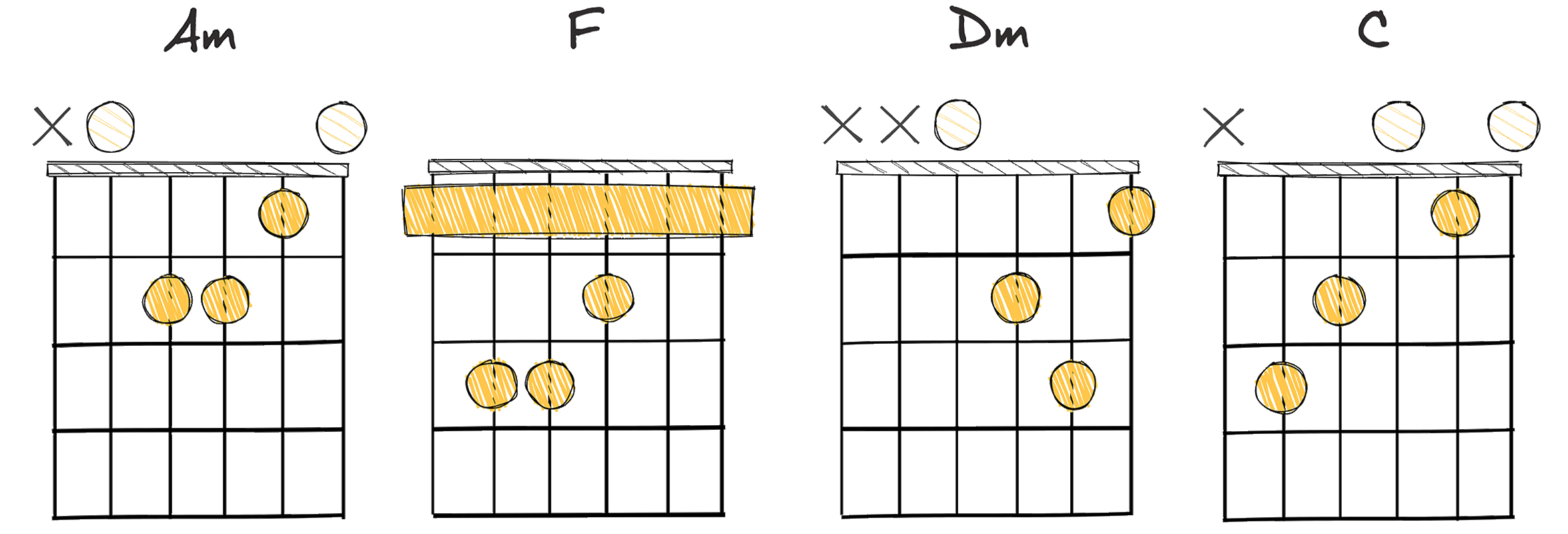
The chord progression vi -IV – ii – I (6-4-2-1) is indeed a great source of eeriness and depth in many musical compositions, providing a sense of intrigue and suspense.
Rich in history, this progression has been utilized across many music genres, from classical to contemporary, and has a special place in the realm of dark and eerie music.
To an intermediate player, this progression can offer both a challenge and a refreshing alternative to more commonly used progressions.
Dating back to classical music eras, this slightly unconventional progression was a favorite of many composers who aimed to create tension and dramatic suspense in their works.
Adopting the A minor – F – D minor – C major (the vi -IV – ii – I in the Key of C), the progression effectively creates a dark and mysterious sound.
This is, in large part, due to the use of the F , which introduces an intriguingly dissonant chord into the progression, while the concluding C major gives a slight, almost imperceptible relief to the tension.
The persistent moodiness and unresolved tension amplified by the minor chords (A minor, F , and D minor) create a uniquely enchanting soundscape.
Its versatility across various keys also lends the vi – IV – ii – I progression an air of unpredictability, allowing artists to inject their unique personality into it.
Ultimately, the vi – IV – ii – I progression’s dark charm lies in its balance of unease and resolution, drawing in musical connoisseurs with its hypnotic allure.
Learning to harness this progression can undeniably give your music an eerie edge, placing your listeners into an immersive experience of suspense, anticipation and release.
The Bottom Line
After thorough analysis and exploration of the various musical progressions, it becomes evident that the harmonic structures i – IV – vii – III (1-4-7-3) and i – vi – IV – ii (1-6-4-2) present a unique blend of tension and resolution, often used to evoke emotional responses within compositions.
The sequences IV – V – I (4-5-1) and i – II – VII (1-2-7) frequently serve as resolutions, providing a soothing end to a varying harmonic journey.
Notably, the progression ii – v – i (2-5-1) is a staple in jazz music due to its strong tonal center and satisfying resolution.
The diversity in these chord sequences represents the range and versatility of music as a powerful tool for storytelling and emotional expression.
Each progression carries its own weight and contributes to the colorful tapestry of musical composition.
In love with guitars, and gear; expert in all things music! Been writing about guitars for about 5 years and counting. Born in the ’90s. Alma Mater: University of Havana. Always curious, trying to understand the world. #TeamFender



